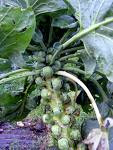Growing sprouts is fairly easy to do, and they are my favourite. They are biennials that are grown as annuals. There are various types and they are divided into groups according to maturity.
The brussel sprout groups are divided into earlies, mid-season, and lates. Of note is that they are very hardy and can survive temperatures well below freezing. Plant heights vary from dwarf sizes of 35 cm to tall sizes of around 75 cm. They are however quite slow growing.
The ideal soil for growing them in is nitrogen rich, and well manured.
They should be sown in middle to late spring, ideally straight in a seedbed, in firm but moist soil, in rows approximately 6 inches apart. The plants should be thinned in early Summer. If they are grown too close together then they will be more consistent in terms of the overall crop, but they will grow smaller in size.
Simply put the more space they have the larger the size and crop, and the crop will last longer enabling harvesting over a longer period.
Caution should be taken as they need careful watering as they like to be kept moist. On taller varieties the stems will need to be earthed up as they grow for support. Discoloured or weak leaves must be removed as soon as possible to prevent disease. As with broad beans keep the bed as weed free as possible.
Brussels are mature and ready to eat around 20 weeks after sowing. To harvest them pick them from the lower part of the plant and then work your way up as the plants mature.
For more information visit growing your own vegetables for a wide variety of vegetable gardening advice and "How to" articles, from broad beans to cucumbers.
Article Source: http://EzineArticles.com/?expert=Richard_Allen
How to Grow Sprouts - Growing Brussel Sprouts
Hi my Name is Darren
I Started Growing my Own Food a few Years ago and i Love it.
When I Started it took Age's to find the Best information on How To Grow my Own Food.
So I have Put Together Some of The Best info I Found to Help others Like me to Grow there own.
Hope you Like it and i Hope it Help's
more will be added as i Find The Best info
Thank's Darren
When I Started it took Age's to find the Best information on How To Grow my Own Food.
So I have Put Together Some of The Best info I Found to Help others Like me to Grow there own.
Hope you Like it and i Hope it Help's
more will be added as i Find The Best info
Thank's Darren
